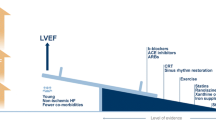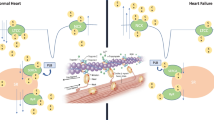Abstract
Background
Cardiac contractility modulation (CCM) is an FDA-approved device therapy for patients with refractory systolic heart failure and normal QRS width. Randomized trials demonstrated benefits of CCM primarily for patients with severe heart failure (> NYHA class II).
Purpose
To better understand individualized indication in clinical practice, we compared the effect of CCM in patients with baseline NYHA class II vs. NYHA class III or ambulatory IV over the 5-year period in our large clinical registry (MAINTAINED Observational Study).
Methods
Changes in NYHA class, left ventricular ejection fraction (LVEF), tricuspid annular plane systolic excursion (TAPSE), NT-proBNP level, and KDIGO chronic kidney disease stage were compared as functional parameters. In addition, mortality within 3 years was compared with the prediction of the Meta-Analysis Global Group in Chronic heart failure risk score.
Results
A total of 172 patients were included in the analyses (10% with NYHA class II). Only patients with NYHA class III/IV showed a significant improvement in NYHA class over 5 years of CCM (II: 0.1 ± 0.6; p = 0.96 vs. III/IV: − 0.6 ± 0.6; p < 0.0001). In both groups, LVEF improved significantly (II: 4.7 ± 8.3; p = 0.0072 vs. III/IV: 7.0 ± 10.7%; p < 0.0001), while TAPSE improved significantly only in NYHA class III/IV patients (II: 2.2 ± 1.6; p = 0.20 vs. III/IV: 1.8 ± 5.2 mm; p = 0.0397). LVEF improvement was comparable in both groups over 5 years of CCM (p = 0.83). NYHA class II patients had significantly lower NT-proBNP levels at baseline (858 [175/6887] vs. 2632 [17/28830] ng/L; p = 0.0044), which was offset under therapy (399 [323/1497] vs. 901 [13/18155] ng/L; p = 0.61). Actual 3-year mortality was 17 and 26% vs. a predicted mortality of 31 and 42%, respectively (p = 0.0038 for NYHA class III/IV patients).
Conclusions
NYHA class III/IV patients experienced more direct and extensive functional improvements with CCM and a survival benefit compared with the predicted risk. However, our data suggest that NYHA class II patients may also benefit from the sustained positive effects of LVEF improvement.



Similar content being viewed by others
Abbreviations
- CCM:
-
Cardiac contractility modulation
- CKD:
-
Chronic kidney disease
- CRT:
-
Cardiac resynchronization therapy
- ESC:
-
European society of cardiology
- FDA:
-
Food and drug administration
- IPG:
-
Implanted pulse generator
- KDIGO:
-
Kidney disease improving global Outcomes
- (LV) EF:
-
(Left ventricular) ejection fraction
- MAGGIC:
-
Meta-analysis global group in chronic [heart failure]
- MAINTAINED:
-
Mannheim cardiac contractility modulation observational study
- NT-proBNP:
-
NT-proB-type natriuretic peptides
- NYHA:
-
New York heart association
- OMT:
-
Optimal medical therapy
- RV:
-
Right ventricular
- TAPSE:
-
Tricuspid annular plane systolic excursion
- vs.:
-
Versus
References
Rao IV, Burkhoff D (2021) Cardiac contractility modulation for the treatment of moderate to severe HF. Expert Rev Med Devices 18(1):15–21. https://doi.org/10.1080/17434440.2020.1853525
Tschöpe C, Kherad B, Klein O, Lipp A, Blaschke F, Gutterman D, Burkhoff D, Hamdani N, Spillmann F, Van Linthout S (2019) Cardiac contractility modulation: mechanisms of action in heart failure with reduced ejection fraction and beyond. Eur J Heart Fail 21(1):14–22. https://doi.org/10.1002/ejhf.1349
Borggrefe MM, Lawo T, Butter C, Schmidinger H, Lunati M, Pieske B, Misier AR, Curnis A, Böcker D, Remppis A, Kautzner J, Stühlinger M, Leclerq C, Táborsky M, Frigerio M, Parides M, Burkhoff D, Hindricks G (2008) Randomized, double blind study of non-excitatory, cardiac contractility modulation electrical impulses for symptomatic heart failure. Eur Heart J 29(8):1019–1028. https://doi.org/10.1093/eurheartj/ehn020
Kadish A, Nademanee K, Volosin K, Krueger S, Neelagaru S, Raval N, Obel O, Weiner S, Wish M, Carson P, Ellenbogen K, Bourge R, Parides M, Chiacchierini RP, Goldsmith R, Goldstein S, Mika Y, Burkhoff D, Abraham WT (2011) A randomized controlled trial evaluating the safety and efficacy of cardiac contractility modulation in advanced heart failure. Am Heart J 161(2):329-337.e321–322. https://doi.org/10.1016/j.ahj.2010.10.025
Abraham WT, Nademanee K, Volosin K, Krueger S, Neelagaru S, Raval N, Obel O, Weiner S, Wish M, Carson P, Ellenbogen K, Bourge R, Parides M, Chiacchierini RP, Goldsmith R, Goldstein S, Mika Y, Burkhoff D, Kadish A (2011) Subgroup analysis of a randomized controlled trial evaluating the safety and efficacy of cardiac contractility modulation in advanced heart failure. J Card Fail 17(9):710–717. https://doi.org/10.1016/j.cardfail.2011.05.006
Abraham WT, Kuck KH, Goldsmith RL, Lindenfeld J, Reddy VY, Carson PE, Mann DL, Saville B, Parise H, Chan R, Wiegn P, Hastings JL, Kaplan AJ, Edelmann F, Luthje L, Kahwash R, Tomassoni GF, Gutterman DD, Stagg A, Burkhoff D, Hasenfuß G (2018) A randomized controlled trial to evaluate the safety and efficacy of cardiac contractility modulation. JACC Heart Fail 6(10):874–883. https://doi.org/10.1016/j.jchf.2018.04.010
Kuschyk J, Roeger S, Schneider R, Streitner F, Stach K, Rudic B, Weiss C, Schimpf R, Papavasilliu T, Rousso B, Burkhoff D, Borggrefe M (2015) Efficacy and survival in patients with cardiac contractility modulation: long-term single center experience in 81 patients. Int J Cardiol 183:76–81. https://doi.org/10.1016/j.ijcard.2014.12.178
Anker SD, Borggrefe M, Neuser H, Ohlow MA, Röger S, Goette A, Remppis BA, Kuck KH, Najarian KB, Gutterman DD, Rousso B, Burkhoff D, Hasenfuss G (2019) Cardiac contractility modulation improves long-term survival and hospitalizations in heart failure with reduced ejection fraction. Eur J Heart Fail 21(9):1103–1113. https://doi.org/10.1002/ejhf.1374
Kuschyk J, Falk P, Demming T, Marx O, Morley D, Rao I, Burkhoff D (2021) Long-term clinical experience with cardiac contractility modulation therapy delivered by the optimizer smart system. Eur J Heart Fail. https://doi.org/10.1002/ejhf.2202
Fastner C, Yuecel G, Rudic B, Schmiel G, Toepel M, Burkhoff D, Liebe V, Kruska M, Hetjens S, Borggrefe M, Akin I, Kuschyk J (2021) Cardiac contractility modulation in patients with ischemic versus non-ischemic cardiomyopathy: results from the MAINTAINED observational study. Int J Cardiol 342:49–55. https://doi.org/10.1016/j.ijcard.2021.07.048
Wiegn P, Chan R, Jost C, Saville BR, Parise H, Prutchi D, Carson PE, Stagg A, Goldsmith RL, Burkhoff D (2020) Safety, performance, and efficacy of cardiac contractility modulation delivered by the 2-lead optimizer smart system: the FIX-HF-5C2 study. Circ Heart Fail 13(4):e006512. https://doi.org/10.1161/circheartfailure.119.006512
McDonagh TA, Metra M, Adamo M, Gardner RS, Baumbach A, Böhm M, Burri H, Butler J, Čelutkienė J, Chioncel O, Cleland JGF, Coats AJS, Crespo-Leiro MG, Farmakis D, Gilard M, Heymans S, Hoes AW, Jaarsma T, Jankowska EA, Lainscak M, Lam CSP, Lyon AR, McMurray JJV, Mebazaa A, Mindham R, Muneretto C, Francesco Piepoli M, Price S, Rosano GMC, Ruschitzka F, Kathrine Skibelund A (2021) 2021 ESC guidelines for the diagnosis and treatment of acute and chronic heart failure. Eur Heart J 42(36):3599–3726. https://doi.org/10.1093/eurheartj/ehab368
Kuschyk J, Nägele H, Heinz-Kuck K, Butter C, Lawo T, Wietholt D, Roeger S, Gutterman D, Burkhoff D, Rousso B, Borggrefe M (2019) Cardiac contractility modulation treatment in patients with symptomatic heart failure despite optimal medical therapy and cardiac resynchronization therapy (CRT). Int J Cardiol 277:173–177. https://doi.org/10.1016/j.ijcard.2018.10.086
Kuschyk J, Kloppe A, Schmidt-Schweda S, Bonnemeier H, Rousso B, Röger S (2017) Cardiac contractility modulation: a technical guide for device implantation. Rev Cardiovasc Med 18(1):1–13
Rich JD, Burns J, Freed BH, Maurer MS, Burkhoff D, Shah SJ (2018) Meta-analysis global group in chronic (MAGGIC) heart failure risk score: validation of a simple tool for the prediction of morbidity and mortality in heart failure with preserved ejection fraction. J Am Heart Assoc 7(20):e009594. https://doi.org/10.1161/jaha.118.009594
Bao J, Kan R, Chen J, Xuan H, Wang C, Li D, Xu T (2021) Combination pharmacotherapies for cardiac reverse remodeling in heart failure patients with reduced ejection fraction: a systematic review and network meta-analysis of randomized clinical trials. Pharmacol Res 169:105573. https://doi.org/10.1016/j.phrs.2021.105573
Imai M, Rastogi S, Gupta RC, Mishra S, Sharov VG, Stanley WC, Mika Y, Rousso B, Burkhoff D, Ben-Haim S, Sabbah HN (2007) Therapy with cardiac contractility modulation electrical signals improves left ventricular function and remodeling in dogs with chronic heart failure. J Am Coll Cardiol 49(21):2120–2128. https://doi.org/10.1016/j.jacc.2006.10.082
Zhang F, Dang Y, Li Y, Hao Q, Li R, Qi X (2016) Cardiac contractility modulation attenuate myocardial fibrosis by inhibiting TGF-beta1/Smad3 signaling pathway in a rabbit model of chronic heart failure. Cell Physiol Biochem 39(1):294–302. https://doi.org/10.1159/000445624
Cappannoli L, Scacciavillani R, Rocco E, Perna F, Narducci ML, Vaccarella M, D’Amario D, Pelargonio G, Massetti M, Crea F, Aspromonte N (2021) Cardiac contractility modulation for patient with refractory heart failure: an updated evidence-based review. Heart Fail Rev 26(2):227–235. https://doi.org/10.1007/s10741-020-10030-4
Gorter TM, van Veldhuisen DJ, Bauersachs J, Borlaug BA, Celutkiene J, Coats AJS, Crespo-Leiro MG, Guazzi M, Harjola VP, Heymans S, Hill L, Lainscak M, Lam CSP, Lund LH, Lyon AR, Mebazaa A, Mueller C, Paulus WJ, Pieske B, Piepoli MF, Ruschitzka F, Rutten FH, Seferovic PM, Solomon SD, Shah SJ, Triposkiadis F, Wachter R, Tschöpe C, de Boer RA (2018) Right heart dysfunction and failure in heart failure with preserved ejection fraction: mechanisms and management. Position statement on behalf of the heart failure association of the European society of cardiology. Eur J Heart Fail 20(1):16–37. https://doi.org/10.1002/ejhf.1029
Go AS, Mozaffarian D, Roger VL, Benjamin EJ, Berry JD, Borden WB, Bravata DM, Dai S, Ford ES, Fox CS, Franco S, Fullerton HJ, Gillespie C, Hailpern SM, Heit JA, Howard VJ, Huffman MD, Kissela BM, Kittner SJ, Lackland DT, Lichtman JH, Lisabeth LD, Magid D, Marcus GM, Marelli A, Matchar DB, McGuire DK, Mohler ER, Moy CS, Mussolino ME, Nichol G, Paynter NP, Schreiner PJ, Sorlie PD, Stein J, Turan TN, Virani SS, Wong ND, Woo D, Turner MB, American Heart Association Statistics C, Stroke Statistics S (2013) Heart disease and stroke statistics–2013 update: a report from the American heart association. Circulation 127(1):e6–e245. https://doi.org/10.1161/CIR.0b013e31828124ad
Author information
Authors and Affiliations
Corresponding author
Ethics declarations
Conflict of interest
BR received lecture fees from Impulse Dynamics Germany GmbH (Stuttgart, Germany). CF received travel allowance and lecture fees from Impulse Dynamics Germany GmbH (Stuttgart, Germany). DB is a paid consultant to Impulse Dynamics (Marlton, NJ, USA). JK works as a consultant for Impulse Dynamics (Marlton, NJ, USA) and received honoraria and lecture fees from this company.
Supplementary Information
Rights and permissions
Springer Nature or its licensor holds exclusive rights to this article under a publishing agreement with the author(s) or other rightsholder(s); author self-archiving of the accepted manuscript version of this article is solely governed by the terms of such publishing agreement and applicable law.
About this article
Cite this article
Fastner, C., Yuecel, G., Hetjens, S. et al. Should HFrEF patients with NYHA class II expect benefit from CCM therapy? Results from the MAINTAINED observational study. Clin Res Cardiol 111, 1286–1294 (2022). https://doi.org/10.1007/s00392-022-02089-w
Received:
Accepted:
Published:
Issue Date:
DOI: https://doi.org/10.1007/s00392-022-02089-w





